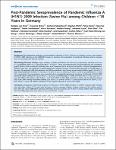Post-Pandemic Seroprevalence of Pandemic Influenza A (H1N1) 2009 Infection (Swine Flu) among Children
Kries, Rüdiger von
Weiss, Susanne
Falkenhorst, Gerhard
Wirth, Stephan
Kaiser, Petra
Huppertz, Hans-Iko
Tenenbaum, Tobias
Schroten, Horst
Streng, Andrea
Liese, Johannes
Shai, Sonu
Niehues, Tim
Girschick, Hermann
Kuscher, Ellen
Sauerbrey, Axel
Peters, Jochen
König, Carl-Heinz Wirsing von
Rückinger, Simon
Hampl, Walter
Michel, Detlef
Mertens, Thomas
Background: We determined antibodies to the pandemic influenza A (H1N1) 2009 virus in children to assess: the incidence of (H1N1) 2009 infections in the 2009/2010 season in Germany, the proportion of subclinical infections and to compare titers in vaccinated and infected children. Methodology/Principal Findings: Eight pediatric hospitals distributed over Germany prospectively provided sera from in- or outpatients aged 1 to 17 years from April 1st to July 31st 2010. Vaccination history, recall of infections and sociodemographic factors were ascertained. Antibody titers were measured with a sensitive and specific in-house hemagglutination inhibition test (HIT) and compared to age-matched sera collected during 6 months before the onset of the pandemic in Germany. We analyzed 1420 post-pandemic and 300 pre-pandemic sera. Among unvaccinated children aged 1–4 and 5–17 years the prevalence of HI titers ($1:10) was 27.1% (95% CI: 23.5–31.3) and 53.5% (95% CI: 50.9–56.2) compared to 1.7% and 5.5%, respectively, for pre-pandemic sera, accounting for a serologically determined incidence of influenza A (H1N1) 2009 during the season 2009/2010 of 25,4% (95% CI : 19.3–30.5) in children aged 1–4 years and 48.0% (95% CI: 42.6–52.0) in 5–17 year old children. Of children with HI titers $1:10, 25.5% (95% CI: 22.5–28.8) reported no history of any infectious disease since June 2009. Among vaccinated children, 92% (95%-CI: 87.0–96.6) of the 5–17 year old but only 47.8% (95%-CI: 33.5– 66.5) of the 1–4 year old children exhibited HI titers against influenza A virus (H1N1) 2009. Conclusion: Serologically determined incidence of influenza A (H1N1) 2009 infections in children indicates high infection rates with older children (5–17 years) infected twice as often as younger children. In about a quarter of the children with HI titers after the season 2009/2010 subclinical infections must be assumed. Low HI titers in young children after vaccination with the AS03B-adjuvanted split virion vaccine need further scrutiny.
No license information
Related Items
Show related Items with similar Title, Author, Creator or Subject.
-
2016-02-18ZeitschriftenartikelVaccine effectiveness in preventing laboratory-confirmed influenza in primary care patients in a season of co-circulation of influenza A(H1N1)pdm09, B and drifted A(H3N2), I-MOVE Multicentre Case–Control Study, Europe 2014/15 Valenciano, Marta; Kissling, Esther; Reuss, Annicka; Rizzo, C.; Gherasim, A.; Horváth, Judit K.; Domegan, L.; Pitigoi, Daniela; Machado, Ausenda; Bella, A.; Paradowska-Stankiewicz, I.; Larrauri, A.; Ferenczi, A.; O´Donell, Joan; Lazar, M.; Pechirra, P.; Korczyńska, M. R.; Pozo, Francisco; Moren, A.Influenza A(H3N2), A(H1N1)pdm09 and B viruses co-circulated in Europe in 2014/15. We undertook a multicentre case–control study in eight European countries to measure 2014/15 influenza vaccine effectiveness (VE) against ...
-
2016-10-13ZeitschriftenartikelImproving influenza virological surveillance in Europe: strain-based reporting of antigenic and genetic characterisation data, 11 European countries, influenza season 2013/14 Broberg, E.; Hungnes, Olav; Schweiger, Brunhilde; Prosenc, Katarina; Daniels, R.; Guiomar, R.; Ikonen, N.; Kossyvakis, A.; Pozo, Francisco; Puzelli, S.; Thomas, I.; Waters, A.; Wiman, Å.; Meijer, AdamInfluenza antigenic and genetic characterisation data are crucial for influenza vaccine composition decision making. Previously, aggregate data were reported to the European Centre for Disease Prevention and Control by ...
-
2013-02-14ZeitschriftenartikelEarly estimates of seasonal influenza vaccine effectiveness in Europe: results from the i-move multicentre case–control study, 2012/13 Valenciano, M.; Kissling, E.We conducted a test-negative case–control study based in five European sentinel surveillance networks. The early 2012/13 adjusted influenza vaccine effectiveness was 78.2% (95% CI: 18.0 to 94.2) against influenza B, 62.1% ...

